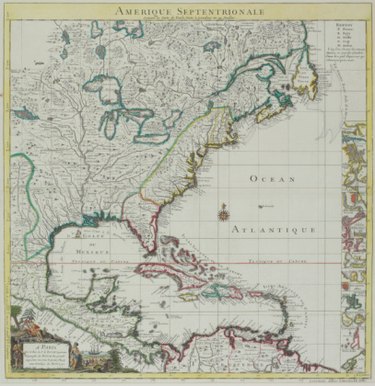
The United States of America has more than 12,000 miles of coastline. This coastline borders three major bodies of water: the Pacific Ocean to the west, the Atlantic Ocean to the east, and the Gulf of Mexico to the southeast. In addition, part of the border with Canada runs through the Great Lakes and the northern coast of Alaska borders the Arctic Ocean.
Pacific Ocean
The Pacific Ocean is the largest body of water in the world, covering about one-third of the Earth's surface. It is larger than all the Earth's land area combined. The Equator divides it into two regions, the North Pacific and South Pacific. The North Pacific borders the contiguous United States along the western shores of California, Oregon and Washington. In addition, Alaska's western coast is on the Pacific. The U.S. state of Hawaii consists of a group of islands in the South Pacific.
Atlantic Ocean
The Atlantic Ocean is the world's second-largest ocean. The eastern seaboard of the United States is located on the western shore of the North Atlantic. Because Britain and Western Europe also border on the Atlantic, the earliest colonization of what would become the United States was along the Atlantic seaboard, with colonies such as Florida, colonized by the Spanish in 1559; Virginia, founded by the English in 1607; and New York, founded by the Dutch in 1609.
Gulf of Mexico
The Gulf of Mexico is technically part of the Atlantic Ocean, but it is so large that it is usually considered as separate. It is about 800 miles long from east to west and borders the U. S. states of Texas, Louisiana, Mississippi, Alabama and Florida, as well as Mexico and Cuba. The largest river in America, the Mississippi River, empties into the Gulf of Mexico. Tropical storms and hurricanes are common in the warm waters of the Gulf, threatening coastal settlements.
Other Bodies of Water
In addition to these three major bodies of water, the United States has some smaller water borders. The northern border of the United States runs along the Great Lakes for part of its length. There are five Great Lakes: Huron, Ontario, Michigan, Erie and Superior. Together they make up the largest group of freshwater lakes in the world. They separate the American states of Minnesota, Wisconsin, Illinois, Indiana, Ohio, Pennsylvania and New York from the Canadian province of Ontario. Also, the northern shore of Alaska is bordered by the Arctic Ocean, which is the smallest of the world's oceans, partly covered by ice throughout the year.